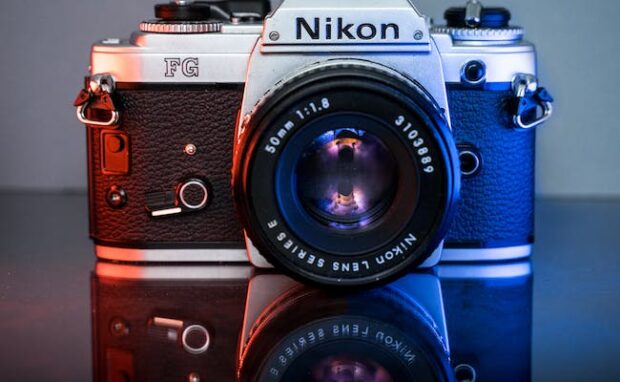Astronaut cameras get new Nikon upgrades
Nikon created special firmware for cameras used by NASA astronauts. Space explorer Don Pettit revealed to PetaPixel that outer space’s cosmic rays can damage camera sensors and ruin pictures. Consequently, the Japanese camera company developed new upgrades to reduce noise and blur caused by these phenomena.
We rely on astronauts taking photos to show what they’ve discovered from their exploration missions. That is why we need them to have cameras suitable for the hostile environment of outer space. Upgrades could capture more detail so that scientists could gain more insights. Also, they allow us to enjoy the majesty of heavenly bodies further.
This article will elaborate on the Japanese camera firm’s new firmware for astronaut cameras. Later, I will share other interesting photos of outer space from the space agency.
What is the new upgrade to astronaut cameras?

Astronaut Don Pettit explained that cosmic rays damage cameras, causing them to produce blurry and grainy images. That is why the Nikon firmware upgrade focused on noise reduction.
“Our cameras in space get sensor damage from galactic cosmic rays, and after about six months, we replace all the cameras, but you still have cameras with significant cosmic ray damage,” Pettit told PetaPixel.
“It shows up at fast shutter speeds, not just the slow ones. So we got Nikon to change the algorithm so that it can do in-camera noise reduction at shutter speeds of up to 500th of a second.”
The astronaut said, “Trying to get rid of it [noise reduction] after the fact is really difficult.” Fortunately, the new firmware for astronaut cameras “does wonders” for eliminating cosmic ray damage.
The Japanese camera company also provided a seemingly mundane upgrade to the file naming system. Most cameras reset numbering photos once you take enough pictures.
You may also like: NASA discovers question mark in space
However, that makes organizing pictures confusing for astronauts who typically capture millions of photos in a mission. “The file naming system on a standard digital system will repeat every so often, and we can’t have two pictures with the same number,” explained Pettit.
“We’ll take half a million pictures with the crew in orbit, and so Nikon has changed the way the RAW files are numbered so that there will be no two with the same file number,” he added.
NASA famously used Hasselblad cameras during the Apollo mission. However, the space agency switched to Nikon because it was adept at making custom modifications for astronauts.
Recent photos taken from outer space
What do all these Hubble images have in common?They show the aftermath of stars that died in a bright, powerful explosion known as a supernova.In a supernova, a star’s contents fling out into space at speeds of up to 25,000 miles (15,000 to 40,000 km) per second! pic.twitter.com/KC5BHNeSZa
— Hubble (@NASAHubble) February 27, 2023
NASA recently shared photos depicting the aftermath of a star’s death. Refer to the X post above to follow along with the descriptions of each image.
The first is at the top left corner, which is the Veil Nebula. It is in the sky of Cygnus, 2,100 light-years away from Earth. For reference, a light-year is 186,000 miles or 300,000 kilometers! The Veil Nebula looks like a tube of glowing air.
Next, the Supernova Remnant DEM L is at the top right corner. They resemble fragile sheets and filaments in the Milky Way Galaxy’s Magellanic Cloud, which is a satellite galaxy.
The third image at the bottom left is the Crab Nebula. It came from a supernova explosion that occurred in 1054 AD.
Lastly, the last image is the Cygnus supernova explosion wave found in the northern constellation of Cygnus.
NASA’s tweet describes them as the remnants of dying stars. These heavenly bodies eventually burn out as they exhaust their nuclear fuel, made of hydrogen, helium, and other elements.
Ironically, stars become larger as they expend more energy, turning into red giants. Once it runs out of fuel, the star collapses, and its outer layers explode as a “supernova.”
You may also like: Amaterasu: Powerful space particle falls to Earth
Consequently, the Hubble images show supernovas, what remains after stars die. Light from these explosions traveled thousands of light years to reach our Space Telescope. That allows Hubble to take these images.
However, these heavenly bodies may have been long gone by the time we could capture photos of them. Fortunately, NASA has been working hard to provide more insights regarding outer space.
Aside from the Hubble star pictures, the organization has been learning more about other planets. For example, NASA’s Mars Lander gathered valuable data about the red planet, showing more details about planets besides Earth.
Conclusion
Astronaut cameras recently gained significant upgrades from Nikon. The Japanese camera firm enhanced its noise reduction to protect images against cosmic rays.
That will enable astronauts to capture clearer images for researchers to study and the public to enjoy. As a result, future photos may provide more insights into outer space.
Do you want to see more outer space images and other interstellar updates? Check them out and other digital tips at Inquirer Tech.